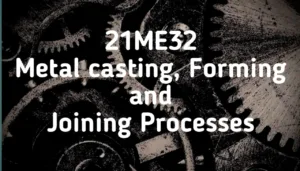
21ME32 Metal casting Forming and Joining Processes
Module 1`
Introduction & basic materials used in foundry: Introduction: Definition, Classification of manufacturing processes.
Metals cast in the foundry-classification, factors that determine the selection of a casting alloy. Introduction to casting
process & steps involved – (Brief Introduction)-Not for SEE
Patterns: Definition, classification, materials used for pattern, various pattern allowances and their importance.
Sand moulding: Types of base sand, requirement of base sand. Binder, Additive’s definition, need and types;
preparation of sand moulds. Molding machines- Jolt type, squeeze type and Sand slinger.
Study of important moulding process: Green sand, core sand, dry sand, sweep mould, CO2mould, shell mould,
investment mould, plaster mould, cement bonded mould.
Cores: Definition, need, types. Method of making cores,
Concept of gating (top, bottom, parting line, horn gate) and risers (open, blind) Functions and types.
Module 2
Melting furnaces: Classification of furnaces, Gas fired pit furnace, Resistance furnace, Coreless induction furnace,
electric arc furnace, constructional features & working principle of cupola furnace.
Casting using metal moulds: Gravity die casting, pressure die casting, centrifugal casting, squeeze casting, slush
casting, thixocasting, and continuous casting processes. Casting defects, their causes and remedies.
Module 3
METAL FORMING PROCESSES
Introduction of metal forming process: Mechanical behaviour of metals in elastic and plastic deformation, stress-strain
relationships, Yield criteria, Application to tensile testing, train rate and temperature in metal working; Hot deformation,
Cold working and annealing.
Metal Working Processes: Fundamentals of metal working, Analysis of bulk forming processes like forging, rolling,
extrusion, wire drawing by slab method,
Other sheet metal processes: Sheet metal forming processes (Die and punch assembly, Blanking, piercing, bending etc.,
Compound and Progressive die), High Energy rate forming processes.
Module 4
JOINING PROCESSES
Operating principle, basic equipment, merits and applications of: Fusion welding processes: Gas welding – Types –
Flame characteristics; Manual metal arc welding – Gas Tungsten arc welding – Gas metal arc welding – Submerged arc
welding.
Module 5
Weldability and thermal aspects: Concept of weldability of materials; Thermal Effects in Welding (Distortion, shrinkage
and residual stresses in welded structures); Welding defects and remedies.
Allied processes: Soldering, Brazing and adhesive bonding
Advance welding processes: Resistance welding processes, friction stir welding (FSW).